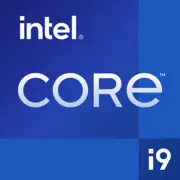Intel Core i9-13900H

Intel Core i9-13900H: Raptor Lake Power in Laptops for 2025
Processor Analysis for Professionals and Gamers
Architecture and Process Technology: Hybrid Cores and New Horizons
The Intel Core i9-13900H processor, built on the Raptor Lake architecture (Intel 7 process technology), combines 14 cores and 20 threads. This hybrid system features:
- 6 Performance-cores (P-cores) with Hyper-Threading support (12 threads) for resource-intensive tasks.
- 8 Efficient-cores (E-cores) for background processes, which reduces power consumption.
The base frequency is 2.6 GHz, with a maximum turbo mode frequency of 5.4 GHz for P-cores. The L3 cache has been increased to 24 MB, which speeds up data processing in games and professional applications.
Integrated Iris Xe graphics (96 EU, up to 1.5 GHz) supports 4K displays, DirectX 12, and AV1 decoding. For lighter games (like CS:GO or Dota 2), it achieves up to 60 FPS at medium settings, but a discrete graphics card is required for AAA titles.
Power Consumption and TDP: Balancing Power and Heat
The nominal TDP is 45 W, but in turbo mode, power can reach 115 W. This requires a well-thought-out cooling system. In compact ultrabooks, the processor is often limited to 35–40 W to reduce temperatures, which slightly decreases performance.
Compared to its predecessor (i9-12900H), Raptor Lake is 10% more energy-efficient due to optimizations in the Intel 7 process technology. However, under load, laptops may become noisy, as fans operate at high speeds.
Performance: From Office Tasks to 3D Rendering
- Office Tasks: Running dozens of tabs in Chrome and working with Excel spreadsheets with millions of rows is handled without delays.
- Multimedia: Rendering 4K video in Premiere Pro takes 15% less time than with the i9-12900H. In Blender (BMW scene), the result is 4.2 minutes compared to 5 for the Ryzen 9 6900HX.
- Gaming: Paired with an RTX 4070 (ASUS ROG Zephyrus laptop) in Cyberpunk 2077 (Ultra, DLSS) — stable 75–90 FPS.
- Turbo Mode: Peak performance lasts 20–30 seconds, after which the frequency drops due to overheating. In gaming laptops with advanced cooling (like MSI Raider), throttling is minimal.
Use Cases: Who is the i9-13900H Suitable For?
1. Professionals: Video editors, 3D designers, programmers will appreciate the multi-threading capabilities.
2. Gamers: Combined with RTX 4060/4070, the processor can unleash the potential of games at 1440p.
3. Creatives: Artists working in Photoshop with 8K images will notice a 20% speedup in filters.
4. General Users: For web surfing or Netflix, the power is excessive, but future-proofing is justified.
Battery Life: The Price of Performance
With a TDP of 45 W, battery life varies significantly depending on tasks:
- Video Playback: Up to 6–7 hours (brightness at 50%, Wi-Fi).
- Office Work: 4–5 hours.
- Gaming: 1.5–2 hours (with dedicated GPU).
Energy savings are provided by:
- Intel Dynamic Tuning 2.0: Automatically reduces frequency during light tasks.
- Adaptive core switching: E-cores handle background processes.
Laptops with larger batteries (like Dell XPS 17 with a 97 Wh battery) can extend battery life to 8 hours in mixed-use.
Comparison with Competitors: AMD, Apple, and Previous Generations
- AMD Ryzen 9 7940HS (Zen 4): Comparable in multi-threaded performance (Geekbench 6 ~12,100), but the i9-13900H wins in single-threaded tasks (+8%). However, Ryzen is more energy-efficient: laptops with similar specs have 1–2 hours more battery life.
- Apple M3 Pro: Lags in benchmarks (Geekbench 6 Multi-Core ~10,500), but runs cooler and lasts up to 12 hours in Safari. However, it’s not suitable for Windows software and gaming.
- Intel Core i7-13700H: About 10–15% weaker in multi-threading but cheaper by $200–300.
Pros and Cons: What to Consider Before Buying
Strengths:
- Best-in-class single-threaded performance.
- Support for DDR5-5600 and PCIe 5.0 (fast SSDs and graphics cards).
- Thunderbolt 4 for connecting external 8K monitors.
Weaknesses:
- Heating under load (up to 95–100°C in thin chassis).
- High laptop prices (starting from $1800).
- Limited gaming potential without a discrete GPU.
Recommendations for Laptop Selection
1. Gaming Models: MSI Stealth 16 (RTX 4070, 240 Hz screen, $2200) — a balance of power and portability.
2. Workstations: Lenovo ThinkPad P16 (4K display, 64 GB RAM, $2500+) — for 3D rendering.
3. Ultrabooks: Asus ZenBook Pro 14 (OLED screen, weight 1.6 kg, $1900) — for designers.
Look for:
- Cooling system (at least 2 fans + heat pipes).
- Battery capacity of 80 Wh or more.
- Thunderbolt 4 and HDMI 2.1 ports.
Avoid budget models with this CPU — they tend to overheat and get noisy.
Final Conclusion: Who is the i9-13900H Designed For?
This processor is the choice for those who need maximum performance in a mobile format. It is ideal for:
- Streamers rendering videos in real time.
- Gamers wanting to play at 1440p without compromises.
- Engineers working with CAD models.
Key Benefits:
- Future-proof with PCIe 5.0 and DDR5.
- Hybrid architecture for intelligent task distribution.
- Compatibility with Windows and all professional software.
If battery life isn’t a priority and the budget allows, the i9-13900H will be a reliable tool for the next 3–4 years.
Basic
CPU Specifications
Memory Specifications
GPU Specifications
Miscellaneous
Benchmarks
Compared to Other CPU
Share in social media
Or Link To Us
<a href="https://cputronic.com/en/cpu/intel-core-i9-13900h" target="_blank">Intel Core i9-13900H</a>

